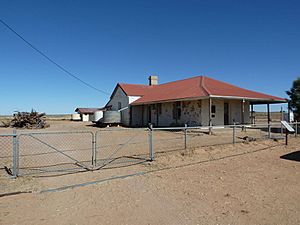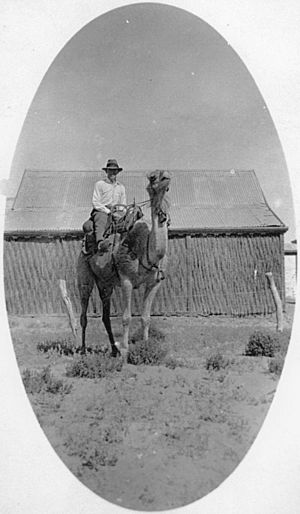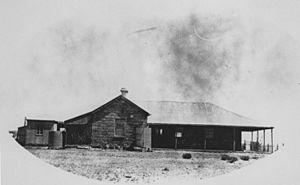Birdsville Courthouse facts for kids
Quick facts for kids Birdsville Courthouse |
|
|---|---|

Birdsville Courthouse, 2011
|
|
| Location | Adelaide Street, Birdsville, Shire of Diamantina, Queensland, Australia |
| Design period | 1870s - 1890s (late 19th century) |
| Built | 1888 - 1890 |
| Architect | Queensland Department of Works |
| Official name: Birdsville Courthouse | |
| Type | state heritage (built) |
| Designated | 21 October 1992 |
| Reference no. | 600460 |
| Significant period | 1880s (historical) 1888-1910s (fabric) |
| Significant components | lock-up, court house |
| Builders | J Wookey and Henry Walton |
| Lua error in Module:Location_map at line 420: attempt to index field 'wikibase' (a nil value). | |
The Birdsville Courthouse is a special old building in Birdsville, Queensland, Australia. It's listed on the Queensland Heritage Register because it's an important part of history. The building was designed by the Queensland Department of Works. It was built between 1888 and 1890 by J Wookey and Henry Walton. Today, it still stands on Adelaide Street.
Contents
A Look Back at the Birdsville Courthouse
How Birdsville Grew
The Birdsville Courthouse was built a long time ago, between 1888 and 1890. It was part of a police and court area. This area is still used today, even though other buildings have changed over time.
European explorers first came to the Diamantina area in the 1840s. But people didn't start farming there until the mid-1870s. Large farms, called pastoral holdings, were set up. These included places like Annandale and Pandie Pandie.
The Town of Birdsville
In the early 1880s, towns like Birdsville and Bedourie were created. They helped serve the new farms. Birdsville was first known as the Diamantina Crossing. It was a stop on a stock route, which was a path for moving animals. This route went from Boulia south to Adelaide.
In 1885, Birdsville became an official town. It was named Birdsville because of all the birds in the area. The local government, called Diamantina Shire, was based in Birdsville until 1953.
Building in the Outback
When the town was surveyed, there were already some buildings. These included hotels, stores, and a police lock-up (a small jail). Most buildings in Birdsville were made from local sandstone. This was because there wasn't much timber around. Also, it was very expensive to bring building materials from far away. The area also had strong storms, so buildings needed to be tough.
Birdsville became an important place for police and border control. It is very far from Brisbane, over 1,000 miles (1,600 km) west. It's also only about 7 miles (11 km) from the border with South Australia. Before Federation (when Australia became one country), different states had their own taxes on goods. Birdsville was one of 14 border posts to collect these taxes.
The town was a key spot for cattle being moved south to Adelaide. By 1889, Birdsville had 110 people. It had many businesses like stores, hotels, and a school. The population grew to 220 people by 1895.
The Courthouse is Built
The Queensland Department of Works built the courthouse. Work started in 1888. It was finished by Henry Walton in 1890. The courthouse was built on the police land. It was part of a group of buildings that included a police station and a lockup. Police in Birdsville even used camels for their work since 1886!
Challenges and Changes
The weather in Birdsville can be very extreme. In 1904, a strong storm "completely wrecked" the police station. Later, in 1954, a whirlwind destroyed the old cell block. A new cell and storage building was built in 1958. Before that, prisoners were sometimes held by handcuffing them to a chain in the yard.
In the 1970s, the lockup was in bad shape. So, in 1974, major repairs were done. They added electric lights and a shower to the cells. A new police house was built in 1980-81. But the old one was still used, especially during the yearly Birdsville Races. This event brings thousands of visitors to the town. Extra police come to help manage the crowds. The old courthouse and police station sometimes provide a place for them to stay.
In 1985, another storm damaged the tracker's quarters (a small building). It was used for storage and was later taken down. A new, modern police station opened in 1988. The old lockup is still there. In 1995, scientists from Japan even put equipment inside it to record things.
The courthouse itself hasn't changed much. But the open porch areas (verandahs) have been closed in. Also, a bathroom and laundry area were added to one side.
What the Courthouse Looks Like
The Birdsville Courthouse is on the eastern side of its land. It looks a bit like the letter 'L'. One part holds the courtroom, and the other part has offices and living areas. It's a single-story building. The main part is made of local stone blocks that are painted. The roof is made of corrugated iron.
The courtroom is on the eastern side. It has open porches (verandahs) on three sides. The roof slopes down at the eastern end and covers these verandahs. The courtroom has a door and two windows on each long side. The main entrance is at the eastern end. Inside, the walls are smooth, and the judge's bench is at the back.
To the west of the courtroom are two rooms. They share a double fireplace (chimney). These rooms connect to what used to be a verandah. This area is now closed in with wooden boards and has windows. To the north are rooms used as a bedroom and a kitchen. A new part was added to the west of the kitchen. This part has a toilet, bathroom, and laundry. Its walls are covered in corrugated iron. Another original verandah to the north of the kitchen has also been closed in. Its new walls have metal on the bottom and glass louvres (slanted window panes) on top.
The old lockup is a simple stone building. It has a gabled roof (a roof that slopes down on two sides) covered in corrugated iron. It has two rooms with a screened porch. There's also a storage area or garage next to it.
Why the Courthouse is Special
The Birdsville Courthouse was added to the Queensland Heritage Register on October 21, 1992. This means it's recognized as an important historical place.
A Link to the Past
The courthouse shows us how Queensland's history unfolded. It's an important reminder of the first farms in the Diamantina area. It also shows Birdsville's role as a border post before Australia became one nation.
A Rare Building
This courthouse is special because it's one of only three old stone buildings left in Birdsville. The other two are the old Royal Hotel (from around 1883) and the Birdsville Hotel (from around 1884). These buildings make Birdsville a unique and historic town.
A Great Example of Design
The courthouse is a good example of a building style used in central Australia. This style helped people deal with the extreme heat and dry weather. It also made up for the lack of timber in the area.
Beautiful to Look At
The courthouse has a special look that helps define the town of Birdsville. It adds to the beauty and character of the area.
Important to the Community
The Birdsville Courthouse has been a central place for justice for a very long time. It has a strong connection with the people living in the surrounding area.



